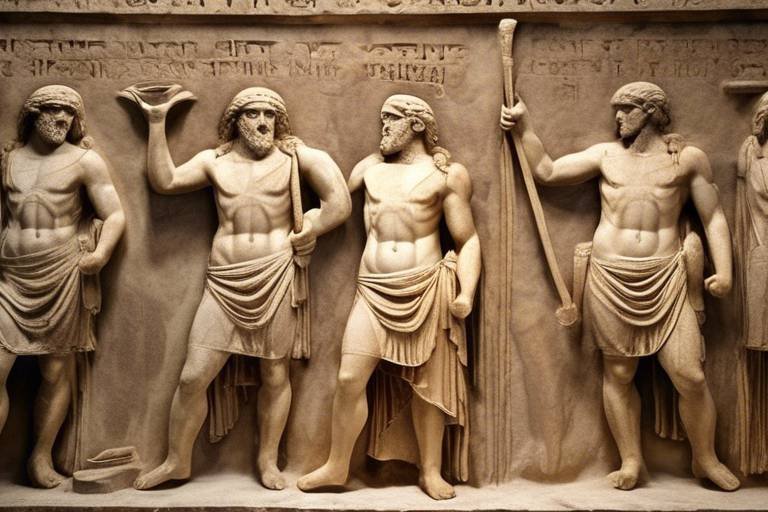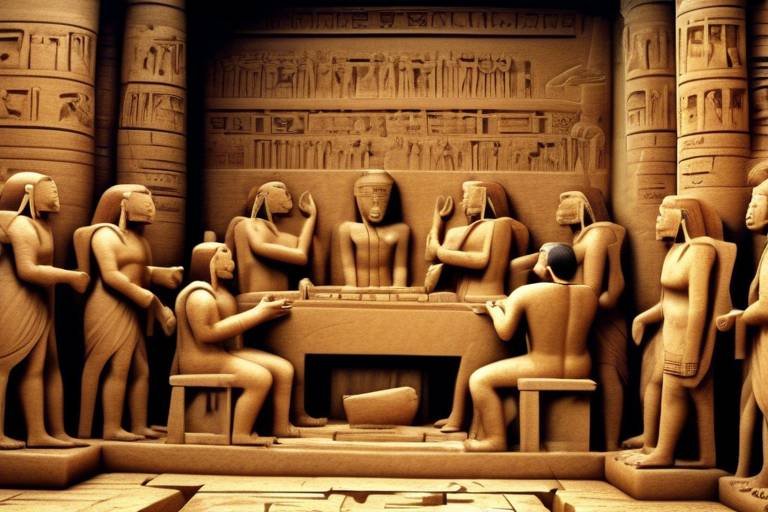The Mystery of the Great Flood in Ancient Texts
Have you ever wondered about the enigmatic tales of catastrophic floods that have been passed down through ancient texts and civilizations? The great flood, a recurring motif in various mythologies and religious scriptures, continues to intrigue and captivate both scholars and enthusiasts alike. Delving into the historical accounts of the deluge, we uncover a tapestry of narratives that transcend time and culture, from the Epic of Gilgamesh to the Biblical story of Noah.
As we embark on a journey through the annals of history, we encounter scientific interpretations that seek to unravel the mysteries shrouding these ancient cataclysms. Geological and archaeological evidence offer tantalizing clues that hint at the occurrence of a monumental flood in antiquity, sparking debates and discussions among experts and researchers.
However, the significance of the great flood extends beyond mere geological phenomena; it is laden with symbolism and cultural meaning that resonate across diverse societies and belief systems. By analyzing the symbolic layers embedded within these narratives, we gain insight into the collective consciousness of humanity and the enduring power of myth.
Comparative mythology invites us to explore the parallels and divergences in flood myths from different cultures worldwide, illuminating universal themes of destruction, rebirth, and divine intervention. Through these comparative analyses, we uncover the threads that connect humanity's shared storytelling traditions.
Were ancient flood narratives perceived as acts of divine wrath or as natural disasters by the civilizations of yore? This question lies at the heart of our exploration, prompting us to ponder the complex interplay between religious beliefs, cultural interpretations, and environmental realities in ancient times.
Amidst the chaos and devastation of the great flood, tales of survival and heroism emerge, showcasing the resilience and ingenuity of the human spirit in the face of adversity. These survival narratives not only inspire awe but also offer profound insights into the values and virtues revered by ancient societies.
As we navigate the turbulent waters of ancient myths, we find striking parallels between these age-old stories and contemporary concerns such as climate change and rising sea levels. The echoes of the past reverberate in the present, urging us to heed the lessons embedded within these timeless tales.
Scholars and researchers have dedicated countless hours to unraveling the enigma of the great flood, offering a myriad of interpretations and theories that shed light on the origins and meanings of these ancient narratives. Their scholarly endeavors enrich our understanding of the cultural tapestry woven by our ancestors.
From literature to art, ancient flood myths continue to exert a profound influence on modern-day culture, shaping our perceptions and interpretations of the world around us. The legacy of these myths endures, reminding us of the enduring power of storytelling and the timeless truths encapsulated within these ancient texts.

Historical Accounts of the Deluge
Historical accounts of the deluge have captured the imagination of civilizations throughout the ages, with stories of catastrophic floods permeating ancient texts and myths. One of the most renowned narratives is found in the Epic of Gilgamesh, an ancient Mesopotamian epic that predates the biblical story of Noah. In this epic, the hero, Gilgamesh, embarks on a quest for immortality and encounters Utnapishtim, the Mesopotamian Noah, who tells him of the great flood that wiped out humanity. The parallels between the Epic of Gilgamesh and the story of Noah's Ark highlight the widespread nature of flood myths across different cultures.
Similarly, the Biblical story of Noah and the Ark is a well-known account of a global flood that serves as a cornerstone of Judeo-Christian beliefs. According to the Bible, God instructed Noah to build an ark to save his family and pairs of animals from the impending deluge. The story emphasizes themes of divine judgment, redemption, and the covenant between God and humanity. The flood narrative in the Bible has been a source of inspiration and contemplation for generations, shaping religious beliefs and cultural practices.

Scientific Interpretations
Have you ever wondered about the stories of catastrophic floods that appear in ancient texts from different cultures around the world? The narratives of great floods, like the Epic of Gilgamesh and the Biblical story of Noah, have captured the imagination of people for centuries, sparking debates about their origins and meanings.
When it comes to exploring the ancient accounts of massive floods, scientists delve into geological and archaeological evidence to uncover possible truths behind these legendary events. The search for scientific explanations behind these ancient flood myths raises intriguing questions about the intersection of myth and reality.

Symbolism and Cultural Significance
Exploring the of the great flood myth takes us on a journey through the depths of human imagination and belief systems. Across various ancient texts and civilizations, the story of a catastrophic deluge has been woven into the fabric of cultural narratives, carrying profound symbolic meanings that resonate through time.
In the Epic of Gilgamesh, the flood symbolizes the wrath of the gods and the cyclical nature of life and death. Similarly, the Biblical story of Noah portrays the flood as a divine punishment for human corruption, but also as a symbol of rebirth and renewal. These narratives reflect the cultural values and beliefs of their respective societies, highlighting the themes of redemption, purification, and the enduring power of faith.
Across different civilizations, the great flood myth is often interpreted as a metaphor for cleansing and transformation. The waters of the flood represent a purifying force that washes away the old world, paving the way for a new beginning. This symbolism is echoed in rituals of baptism and purification found in various religious traditions, underscoring the enduring cultural significance of the flood narrative.
Moreover, the great flood myth serves as a universal symbol of humanity's vulnerability in the face of natural forces beyond our control. It speaks to our collective fears and hopes, reminding us of the fragility of existence and the resilience of the human spirit. The flood myth transcends cultural boundaries, resonating with people across time and space, and offering timeless lessons about the cyclical nature of life, the impermanence of earthly power, and the enduring quest for meaning and transcendence.

Comparative Mythology
When delving into the realm of comparative mythology, one is met with a tapestry of diverse narratives woven across different cultures and civilizations. These ancient stories, despite originating from geographically distant lands, often exhibit striking similarities that transcend boundaries of time and space. Through the lens of comparative mythology, scholars aim to unravel the common threads that bind these tales of catastrophic floods, seeking to uncover universal truths embedded within the rich tapestries of human imagination.
One of the most intriguing aspects of comparative mythology is the identification of recurring motifs and archetypes within flood narratives. From the epic of Noah's ark in the Bible to the Mesopotamian tale of Utnapishtim in the Epic of Gilgamesh, the motif of a great deluge wiping out humanity only to be survived by a chosen few resonates across cultures. This shared motif raises thought-provoking questions about the collective unconsciousness of humanity and the enduring power of storytelling to transcend cultural boundaries.
Moreover, comparative mythology allows for a deeper exploration of the symbolic meanings embedded within flood myths. The floodwaters, often representing chaos and destruction, are followed by a period of renewal and rebirth. This cyclical motif of destruction and regeneration mirrors the natural rhythms of the world, symbolizing the eternal struggle between order and chaos, creation and destruction.
By comparing flood myths from civilizations as diverse as ancient Mesopotamia, Egypt, China, and the Americas, scholars can discern both shared themes and unique variations in the narratives. While some cultures depict the flood as a punishment inflicted by vengeful deities, others view it as a necessary cleansing of the world to pave the way for a new beginning. These nuanced differences in interpretation offer a fascinating glimpse into the diverse ways in which human societies have grappled with the existential questions of life, death, and the forces of nature.

Divine Wrath or Natural Disaster?
One of the most intriguing aspects of ancient flood narratives is the debate surrounding whether these catastrophic events were perceived as divine wrath or natural disasters by the civilizations of that time. In many myths and religious texts, the great flood is often depicted as a punishment from the gods for the sins of humanity. The idea of a vengeful deity unleashing a deluge to cleanse the world of corruption and wickedness is a recurring theme in various cultural accounts.
On the other hand, scientific interpretations offer a different perspective, suggesting that these ancient flood stories could be based on real geological events. Evidence from archaeological excavations and geological studies has led researchers to speculate that certain regions might have experienced massive floods in antiquity due to natural phenomena such as glacial melting or tectonic activities.
While some cultures may have viewed the flood as a divine punishment, others might have seen it as a natural disaster caused by environmental factors beyond human control. The interpretation of these cataclysmic events sheds light on the worldviews and beliefs of ancient societies, revealing how they perceived the forces of nature and their place in the cosmos.
Moreover, the dichotomy between divine wrath and natural disaster raises profound questions about the interplay between religion and science in explaining historical phenomena. Were the great floods manifestations of supernatural retribution or were they simply the result of environmental upheavals that shaped the course of human history?
Ultimately, the interpretation of ancient flood narratives as either divine wrath or natural disaster continues to spark debate among scholars and researchers, highlighting the complexity of understanding the mythological and historical significance of these legendary events.

Survival Narratives and Heroes
When delving into the ancient texts recounting the great flood, one cannot ignore the recurring motif of survival and the emergence of heroic figures amidst the chaos. These narratives often depict individuals who, against all odds, manage to navigate the treacherous waters and emerge as symbols of resilience and hope. Just like a lone sailor braving a stormy sea, these heroes stand as beacons of light in the darkness, showcasing the indomitable human spirit in the face of overwhelming adversity.
One such legendary figure is Utnapishtim from the Epic of Gilgamesh, who was forewarned about the impending flood by the gods and instructed to build an ark to save himself, his family, and a pair of each living creature. Similarly, the story of Noah in the Bible portrays him as a righteous man chosen by God to construct an ark and preserve life on Earth during the cataclysmic deluge. These tales of survival not only captivate our imagination but also instill a sense of awe at the resilience and ingenuity displayed by these ancient heroes.
Through these survival narratives, ancient cultures sought to convey profound lessons about human perseverance, faith, and the enduring power of hope in the face of seemingly insurmountable challenges. The flood stories serve as reminders that even in the darkest of times, there is always a glimmer of light, a chance for renewal and rebirth amidst the devastation. Just as the floodwaters recede, leaving behind a cleansed world, the heroes of these tales emerge as symbols of renewal and the triumph of the human spirit over adversity.
As we reflect on these ancient survival narratives and the heroes they immortalize, we are reminded of our own capacity to weather life's storms and emerge stronger on the other side. The stories of Utnapishtim, Noah, and other flood heroes continue to inspire us to persevere in the face of challenges, to hold onto hope when all seems lost, and to believe in the possibility of a new beginning even in the midst of destruction.

Modern-Day Parallels
Many ancient texts and civilizations have left behind narratives of a great flood, sparking curiosity and debate among scholars and enthusiasts alike. These stories, such as the Epic of Gilgamesh and the Biblical tale of Noah, have captivated the imagination of generations, hinting at a shared human experience that transcends time and geography.
As we delve into the ancient accounts of catastrophic floods, it's intriguing to draw parallels with the environmental challenges faced in the modern world. Could these ancient tales serve as cautionary reminders of the potential consequences of climate change and rising sea levels?
Imagine the floodwaters of the past as a metaphor for the rising tides of today, threatening coastal communities and ecosystems. Just as heroes emerged in ancient narratives to navigate the deluge and ensure survival, are we now called to rise to the challenge of protecting our planet and securing a sustainable future?
Considering the intricate balance between nature and humanity, it becomes evident that the echoes of the great flood myths resonate in our current environmental discourse. The urgency to address global warming and its repercussions mirrors the urgency felt by those facing the wrath of ancient floods, urging us to act decisively and collaboratively.
Stay tuned for answers to common queries about the great flood myths, their significance, and the enduring legacy they hold in our collective consciousness.

Interpretations by Scholars
When it comes to unraveling the enigmatic tales of ancient floods, scholars have delved deep into the realms of history, mythology, and archaeology to provide diverse interpretations. One prevalent view among scholars is the symbolic significance attached to these narratives. Some argue that the great flood stories symbolize a cleansing or renewal of the world, representing a cyclical pattern of destruction and rebirth in various cultures.
Moreover, scholars have explored the psychological and sociological implications of flood myths. They suggest that these stories might reflect collective traumas or fears of catastrophic events ingrained in the human psyche. By analyzing the cultural contexts in which these narratives emerged, scholars aim to uncover the underlying beliefs and values of ancient societies.
Additionally, scholars have debated the possible historical origins of flood myths. While some propose that these stories could be based on actual geological events, others argue that they are purely mythical constructs. By examining geological data, ancient texts, and oral traditions, scholars attempt to piece together the puzzle of the great flood and its significance in human history.
Furthermore, scholars have highlighted the cross-cultural similarities and variations in flood myths from different civilizations. By conducting comparative studies, they seek to identify common motifs, archetypes, and themes that transcend geographical and temporal boundaries. Through these comparative analyses, scholars aim to gain insights into the universal aspects of human storytelling and belief systems.
In the realm of academia, interpretations of ancient flood narratives continue to evolve as new discoveries and interdisciplinary approaches shed light on these age-old mysteries. Scholars from various fields, including archaeology, anthropology, and religious studies, collaborate to offer nuanced perspectives on the meanings and implications of the great flood stories. By engaging in scholarly discourse and critical analysis, researchers strive to unravel the complexities of these ancient texts and their enduring impact on human culture.

Legacy and Influence
Ancient flood myths have left a lasting legacy on human culture, influencing various aspects of society from literature to art and even popular culture. These tales of catastrophic deluges have captured the imagination of people for centuries, resonating with themes of destruction, rebirth, and the resilience of the human spirit. The enduring influence of these narratives can be seen in the way they continue to be retold and reinterpreted in modern times, shaping our understanding of the world and our place within it.
Frequently Asked Questions
- What is the significance of the great flood in ancient texts?
The great flood in ancient texts holds immense symbolic and cultural significance across various civilizations. It is often interpreted as a transformative event, symbolizing rebirth, purification, or divine judgment.
- Are there scientific explanations for the occurrence of a great flood in ancient times?
While the great flood narratives in ancient texts are primarily mythological, some scientists suggest that these stories could be inspired by real-life catastrophic events like tsunamis or flooding due to climate change. However, concrete scientific evidence supporting a global deluge is yet to be found.
- How do ancient flood myths compare across different cultures?
Ancient flood myths from various cultures share common themes such as divine punishment, survival, and the emergence of heroes. However, there are also significant variations in the details and interpretations of these stories, reflecting the diverse beliefs and values of different societies.
- What is the relevance of ancient flood narratives to modern-day issues?
Ancient flood myths resonate with contemporary concerns such as climate change and environmental degradation. They serve as cautionary tales about the consequences of human actions on the natural world, prompting reflection on our relationship with the environment and the need for sustainable practices.



















